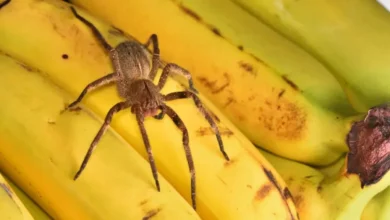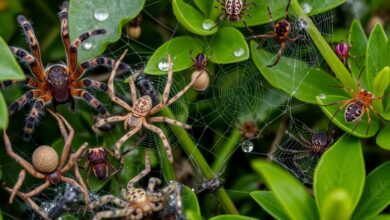Discover Banana Spiders: Facts and Fascinating Info
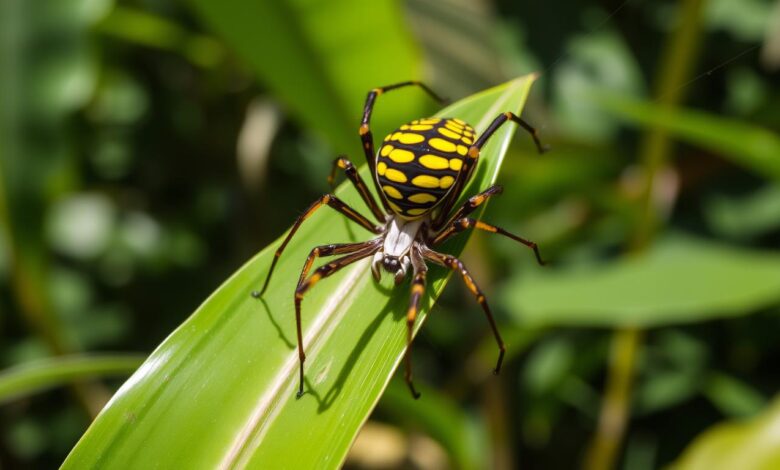
Banana spiders, also known as golden silk orb-weavers, are fascinating tropical arachnids. They are famous for their amazing web-spinning skills and bright colors. These big, orb-shaped spiders live in the world’s tropical areas, making huge, wheel-shaped webs.
Their long legs and big belly make them look like bananas. This is why they are called “banana spiders.”
Banana spiders are venomous but not harmful to humans. Their venom isn’t strong enough to hurt us. These spiders are important in their ecosystems, both as predators and prey.
Learning about their biology, behavior, and conservation is interesting. It helps us understand the natural world better.
In this article, we’ll explore the world of banana spiders. We’ll look at their looks, homes, web-making skills, and their role in nature. If you love nature or just want to learn about these exotic species, you’ll find interesting facts about banana spiders here. You’ll surely appreciate these web spinners more.
What is a Banana Spider?
Appearance and Identification
Banana spiders, known scientifically as Nephila species, are large, orb-shaped spiders. They live in tropical and subtropical areas worldwide. Their long, slender legs and rounded, bulbous abdomen make them stand out.
Their bodies are often yellow, orange, or golden. They have intricate patterns that help them blend in with their surroundings.
Common Names and Scientific Classification
Banana spiders are also called golden silk orb-weavers, giant wood spiders, and writing spiders. These names highlight their unique looks and web-spinning skills. They belong to the Nephila genus, which is part of the Nephilidae family.
The Nephila genus has over 40 species. The most famous is the golden silk orb-weaver (Nephila clavipes). They are found in tropical and subtropical areas.

Banana Spider Habitats and Distribution
Banana spiders are found in many places around the world. They live in warm, humid areas like forests and woodlands. They even make their homes in cities with lots of greenery.
These spiders are very good at living in different places. They spin big webs between trees and shrubs. This lets them live in many different environments.
Banana spiders love warm, humid places. They live in Africa, Asia, Australia, and the Americas. Countries like Brazil, India, and Thailand have lots of them.
In forests, they live high up in the trees. They have plenty of food and shelter there. But they also live in cities, making webs in parks and gardens.
| Region | Banana Spider Habitat | Distribution |
|---|---|---|
| Tropical Africa | Forests, woodlands, urban areas | Common in countries like Kenya, Tanzania, and South Africa |
| Subtropical Asia | Forests, gardens, urban areas | Found in India, Thailand, and parts of China |
| Tropical South America | Rainforests, plantations, suburban areas | Widespread in countries like Brazil, Colombia, and Ecuador |
| Subtropical Australia | Coastal forests, urban gardens | Native to northeastern parts of the country |
Banana spiders live in many places. They are very good at adapting to different environments. Whether in forests or cities, they are always fascinating to see.

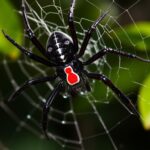 Redback Spider: Australia’s Notorious Arachnid
Redback Spider: Australia’s Notorious Arachnid
The Amazing Web-Spinning Abilities of Banana Spiders
Banana spiders are known for their amazing web-spinning skills. They create the largest and most detailed orb-shaped webs in the animal world. Their long, slender legs help them build these huge, wheel-like webs. These webs can be several feet wide and have beautiful patterns.
The webs are not just traps for prey. They also show the spider’s incredible engineering skills.
Intricate Web Designs
Banana spiders are experts at web design. They make orb-shaped webs that are both beautiful and useful. Their webs can reach up to 6 feet in diameter.
These webs have intricate spiral patterns and radial spokes. They form a wheel-like shape. This design is key to their hunting success, catching many flying insects.
Silk Production and Properties
Banana spiders are famous for their silk production. They use this silk to make their elaborate webs. They have special glands that let them make different types of silk.
The most famous aspect of their silk is its golden color. This color comes from specific pigments and proteins. The golden silk is not only beautiful but also very strong and elastic.
Scientists have studied this silk. They found it to be one of the toughest and most resilient natural materials. It has many uses, like in textiles, engineering, and medicine.

Banana Spiders: Venomous or Harmless?
Many people think banana spiders are very dangerous. But, the truth is they are not a big threat to humans. Their venom is not strong and usually doesn’t cause serious problems.
Banana spiders have venom to catch their food. But, their venom is not very strong. Their fangs also can’t easily bite humans. A bite might cause some pain, swelling, and redness, but it’s not dangerous.
Banana spiders are not aggressive towards people. They only bite when they feel threatened. They usually try to stay away from humans. So, they are more interesting to watch than dangerous.
Even though we should be careful around them, banana spiders are harmless to us. Their venom might hurt a bit, but it’s not a big deal. Knowing this, we can enjoy watching these amazing banana spiders without worry.

Banana Spider Diet and Hunting Techniques
Banana spiders are opportunistic predators. They feed on a wide range of flying insects and small invertebrates. Their large, wheel-shaped webs catch flies, moths, grasshoppers, and even small birds and bats.
When a creature gets caught in the web, the banana spider quickly acts. It wraps the prey in silk and injects venom to subdue it.
Prey and Food Sources
Banana spiders use their chelicerae (fangs) to pierce their prey. They inject digestive enzymes, liquefying the prey’s internal tissues. This way, they can consume the nutritious fluids.
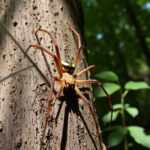 Huntsman Spider: All About These Large Arachnids
Huntsman Spider: All About These Large Arachnids
This skill in capturing and feeding on various prey helps banana spiders thrive. They live in tropical and subtropical habitats.
While the banana spider diet includes many insects, they are especially good at hunting:
- Flies
- Moths
- Grasshoppers
- Small birds
- Bats
The banana spider’s hunting techniques are very effective. They can catch a wide range of banana spider prey. This ensures they have a steady food source in their natural environments.
Lifecycle and Behavior of the Banana Spider
The banana spider, also known as the giant wood spider or the golden orb-weaver, has a fascinating life cycle. From tiny spiderlings hatching from egg sacs, they grow and develop in an amazing way.
Young banana spiders go through molting stages, shedding their skin as they grow. Females are much larger than males, with bodies reaching several inches in diameter. This banana spider size difference is a key part of their behavior and reproduction.
Banana spiders live alone, each building its own web. These webs are not just for catching prey but also play a big role in their life cycle. During courtship, males perform dances to attract females.
After mating, the female banana spider guards an egg sac with hundreds of eggs. The banana spider lifespan varies, but females often live longer than males.
| Banana Spider life cycle Stage | Key Features |
|---|---|
| Spiderling | Tiny, newly hatched banana spiders |
| Molting | Shedding exoskeletons as they grow |
| Size Difference | Females significantly larger than males |
| Solitary Behavior | Each spider constructs and maintains its own web |
| Courtship Ritual | Male spiders perform elaborate dances to attract mates |
| Egg Sac | Females produce and guard hundreds of eggs |
| Lifespan | Females typically outlive shorter-lived males |
Learning about the life cycle of a banana spider and behavior of banana spiders gives us insights into their amazing adaptations and survival strategies.
Encountering Banana Spiders in the Wild
Seeing a banana spider in nature is amazing. But, it’s crucial to be careful to keep everyone safe. These big spiders usually don’t attack humans unless they feel scared.
Safety Tips and Precautions
It’s wise to keep a safe distance from banana spiders. Don’t touch or handle them, as it might make them defensive. Just admire their webs and the important role they play in nature. By doing this, you can enjoy their beauty without any danger.
- Maintain a safe distance from the spider’s web and habitat
- Avoid touching or handling the banana spider
- Appreciate the spider’s natural behaviors and role in the ecosystem
- Be cautious when hiking or exploring areas known to be banana spider habitats
Knowing how to safely meet banana spiders is important. Following safety tips lets you enjoy these amazing creatures. You can what to do if you see a banana spider and explore nature safely.
The Role of Banana Spiders in Ecosystems
Banana spiders, also known as golden orb-weaver spiders, are key to healthy ecosystems. They eat many flying insects, helping to keep pest populations down. This is good for crops and homes.
These spiders eat a lot of insects, keeping their numbers in check. Their big webs are not just for catching prey. They also offer homes to birds and other small animals. These webs are a food source for insects that eat other insects.
Banana spiders show how connected and complex tropical and subtropical ecosystems are. They help keep their environments healthy and full grown banana spider of life. This ensures that many different species can live together.
Scientists are very interested in banana spiders. They study their webs, silk, and how they might help us. By learning about and protecting banana spiders, we help keep our ecosystems balanced and diverse.
Banana Spider Research and Conservation Efforts
Banana spiders have always fascinated scientists and researchers. They spend hours studying these amazing arachnids. They look into their silk, mating rituals, and web-spinning.
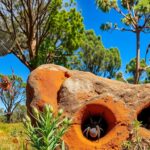 Discover Spiders in Australia: Your Arachnid Guide
Discover Spiders in Australia: Your Arachnid Guide
Conservation is also key. Banana spiders face threats like habitat loss and pesticides. Researchers and conservationists work hard to protect them. They aim to save their habitats for future generations.
As we learn more about banana tarantula, their unique traits excite scientists and the public. Their research and conservation efforts look promising. This shows us the wonders of nature and the possibilities ahead.

